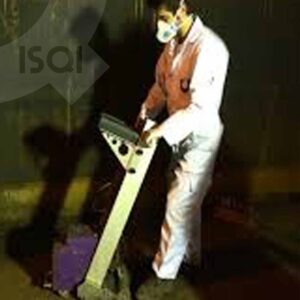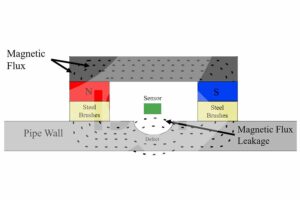Magnetic Flux Leakage (MFL) is one of the non-destructive testing methods used to detect corrosion and voids in steel structures, such as pipelines, tank bottoms, pressurized vessels, and storage tanks, where it is applied on insulated and painted surfaces. The fundamental principle of this method relies on a strong magnetization of the steel. In areas where corrosion or missing metal occurs, the magnetic field “leaks” from the steel. In the MFL method, magnetic sensors are used between the poles of the magnet to detect leakage. Subsequently, this leakage is examined to estimate the depth of metal loss.
Defects such as cracks, voids, seams, cuts, laps, holes, and other imperfections interrupt the magnetic flux field and “leak” outside the surface of the component. It should be noted that the magnetic poles and sensors are oriented 90 degrees relative to the direction of movement.
This electromagnetic testing method is also used for the inspection of ferromagnetic metals with high permeability, such as carbon steel rods, plates, wire ropes, sucker rods, and coupling stock. Additionally, this method can be employed for detecting ferritic inclusions in non-ferritic materials.
MFL inspection utilizes a DC magnetic field to generate flux density. To accurately locate the precise location of defects, it is essential to note that a transverse magnetic field is employed for detecting longitudinal defects, while a longitudinal field is used for identifying transverse defects.









